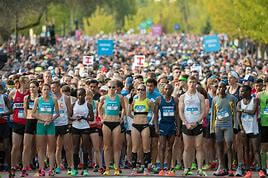No Matter what age you are or where you are from, the Marathon is world renowned and here is a guide to help you prepare and get the best time you can! How to train for a marathon.
The eternal question – How much training do you need to do?
For the marathon, 12 weeks is the minimum recommendation – but you might want to set a target and aim for a halfway point. The best preparation would be to split your training plan into 2 six-week blocks to give yourself a training focus and small achievable goals for the period.
What’s the important tell all session and why?
Well it really depends on what phase, shape and training block you’re in and of course not panicking, but for most the most important recognised session will be the strength training. Research suggests the stronger you are, the less likely you are to get injured – and the better your running economy is, so don’t forget muscle strength.
So how do you get faster for a Marathon?
Build both physical strength and interval work sessions – short high-intensity running bursts coupled with some very easy recovery running – into your training plan. If your sessions are based around long slow steady runs all the time without any faster shorter runs, that’s how you’ll race, slow!
Check out the Marathon Training Plan
Where do most people go wrong?
The most frequent and common mistake is not taking enough rest days. you must take care of yourself and have a sound recovery strategy.Having this in place really will ensure you can train hard and get the most out of every session and keep your body in one piece
How To Avoid Injury
When you start training for a marathon most people will straight away do more running than they have ever done before. Hopefully you understand the role of injury prevention and this should not be you.
A gradual, planned increase in your running is the primary key to avoiding injuries. If you’re following a structured training plan then this has been considered and worked into the progression correctly.
As stated Strength training that focuses on your legs and core musculature will aid your body prepare for the demands of running a marathon.
Another thing to check if you are picking up niggles constantly is whether you’re wearing the right kind of running shoes for you. Check the gear section below for advice on gait analysis.
Some injuries are completely unavoidable, of course, and even if you do everything you can to prepare your body for the demands of marathon training it can break down. Be sensible about it if that does happen – go and see a physio, and don’t worry if it ultimately means that you can’t run your marathon. There will always be another race, as long as you don’t destroy your body by running through the pain.
Make sure you have a recovery Strategy
And know what is affecting your Recovery
Picking Your Marathon Running Shoes
The most important part of any running programme starts at the bottom. You’re going to be spending thousands of steps every day in the shoes you use for your marathon training, so it’s vital you get the right ones. If you already have a preferred style and brand and you have no injuries form them, then stick with them – if it ain’t broke, don’t fix it. If it is broke, in that you are uncomfortable in your shoes or pick up a lot of injuries,its time to get new!
Many running shops perform a gait analysis for free. A quick run on a treadmill will help an expert ascertain if you overpronate (where your foot rolls too far inwards when it lands) or underpronate (it doesn’t roll far enough), or if you are a neutral runner. More advanced gait analysis will also look at how your entire body moves when running, but this is probably only worth doing if you are suffering from a lot of injuries and then it’s best to visit a physio for advice.
And then once you know the right type of shoes for you (don’t have to buy from the same store remember), test some on a treadmill in the store if possible.
But of course take note, you will want a cushioned shoe for marathon training, because after a fair few miles your feet are going to hurt. If you can stretch to more than one pair, then it can be worth getting a lighter, less cushioned pair too, for faster interval sessions in training, and maybe race day itself – although be wary of using the ultra-light shoes favoured by pros, because they might not be cushioned enough for regular Joes.
One last point in this section – do not, under any circumstances, buy a shiny new pair of shoes at your marathon expo and wear them for the first time on race day. That goes for all your gear – you want tried-and-tested stuff that won’t annoy, chafe or injure you.
The Running Gear You Need For A Marathon
When it comes to your marathon outfit, it’s worth investing in technical garb that wicks sweat away and doesn’t irritate. Don’t forget to extend these principles to your socks and underwear. You might only run one marathon in your life, so it’s worth splashing out on some top-quality kit to make sure the memory isn’t ruined by blisters or *shudders* chafing.
You’ll also need a method to carry some kind of sustenance with you while you run. There will be drinks on the course, but if you’re using energy gels or bars, you should bring ones that you’re used to with you to avoid any stomach… unpleasantness. A running belt with space for your gels, phone and headphones is a useful purchase.
Check out the Marathon Training Plan
How To Fuel Your Running
During your training the main general dietary advice is to ensure you’re eating enough carbs to fuel your exercise, protein to help your muscles rebuild and recover, and fruit and vegetables to keep your immune system in good shape – especially if you’re training in the winter.
You need to also start thinking about in-run nutrition and hydration when your training runs are longer than 90 minutes. Make sure you increase your carb consumption before those runs, and consider carrying gels or another source of carbs with you to restock during the run. Running gels are popular because they are easy to carry and consume on the move.
Staying hydrated is also vital, and this means topping up electrolytes like sodium as well as glugging down plenty of water. Sports drinks contain electrolytes as well as carbs, or you can buy tablets you dissolve in water to create an electrolyte-rich drink.
For your final few long runs before the marathon you should be trying to replicate the nutrition you will be using on race day itself so your body gets used to the gels and drinks. Gels in particular can upset your stomach, and how they affect you varies from brand to brand, so keep trying till you find one that works for you.
Check out the Marathon Training Plan




